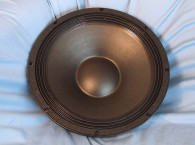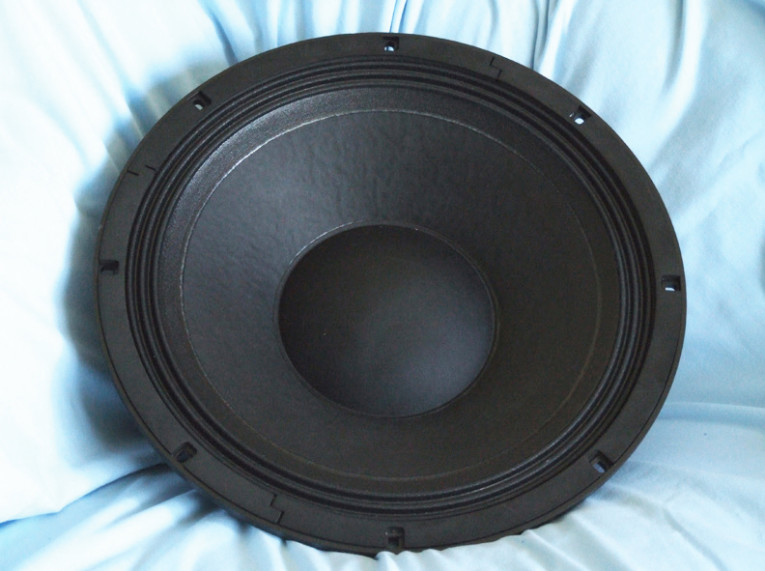
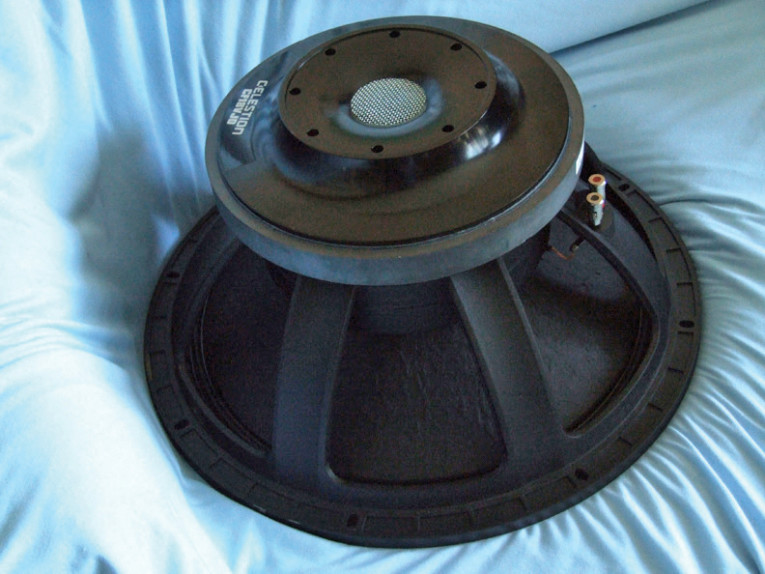
Instead, Celestion uses a vented front plate that exhausts toward a series of peripheral vents located on the top of the back plate. The cone assembly consists of an 18” carbon and Kevlar loaded paper cone and a large 6.5” diameter carbon and Kevlar-loaded paper dust cap. Suspension is provided by a three-roll M-shaped coated (sealed) cloth surround in conjunction with two 7.5” diameter flat treated-cloth spiders (dampers), which I would assume are mounted back to back to cancel out odd-order nonlinearity. All this is driven by a 5” (125-mm) diameter high-temperature non-conducting voice coil former wound with a two-layer inside/outside round copper wire winding. The voice coil is terminated to a pair of color-coded chrome push terminals.
I immediately noticed the CF18VJD’s massive ferrite finite element analysis (FEA) optimized motor assembly. This consists of a single 25-mm × 270-mm ferrite magnet sandwiched between a black coated 250-mm diameter front plate that forms the 12-mm gap area and a 250-mm diameter × 40-mm high-milled shaped T-yoke, also black coated. Besides the eight 9-mm diameter peripheral vents in the back plate for cooling and transmitting air from the vented front plate, the T-yoke also incorporates a 52-mm pole vent. Also included in the motor structure are a set of dual shorting rings (Faraday shields) to reduce flux modulation and distortion.
I clamped the CF18VJD driver to a rigid test fixture in free air at 1, 3, 6, 10, 15, 20, and 30 V. Then, I used the LinearX LMS and VIBox to produce voltage and admittance (current) curves. I use a procedure that attempts to achieve the third-time constant on each sweep, so the LMS oscillator is turned on for a progressively increasing time period between sweeps.
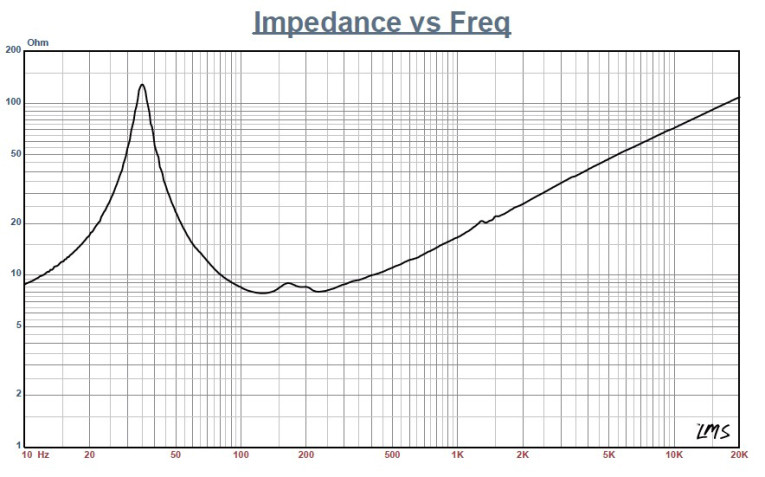


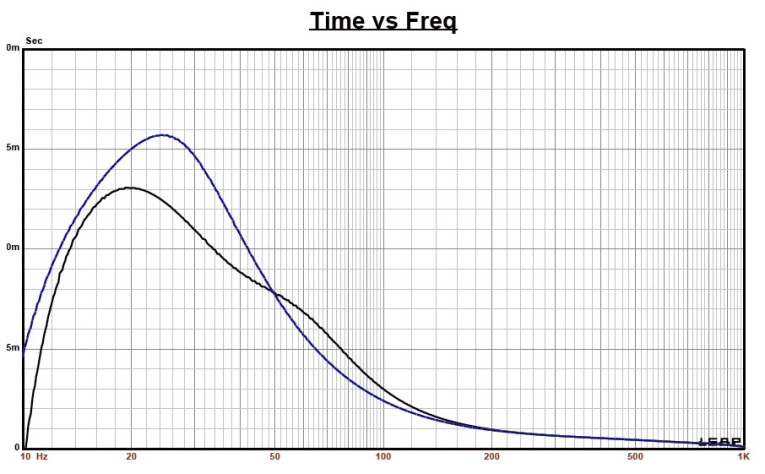

Following established Test Bench test protocols, I no longer use a single added mass measurement. Instead, I used the actual measured cone assembly weight that Celestion provided at my request. Next, I post-processed the 14 550-point stepped sine wave sweeps for each sample and divided the voltage curves by the current curves to derive the impedance curves. Then, I calculated the phase (LMS is a single-channel analyzer and does not measure phase, but it does have a highly accurate phase-proprietary calculation methodology). Next, I imported them along with the accompanying voltage curves into the LEAP 5 Enclosure Shop software. This is a more time consuming process than the usual low-voltage, small-signal impedance curve technique used to derive Thiele-Small (T-S) parameters. The reason for this is that the LEAP 5 LTD transducer model methodology results in a more accurate prediction of excursion at high voltage levels, which is one of the LEAP 5 software’s real fortes.
Because most T-S data provided by OEM manufacturers is produced using either a standard modeling method or the LEAP 4 TSL model, I also created a LEAP 4 TSL model using the 1-V free-air curves. The complete data set, the multiple voltage impedance curves for the LTD model, and the 1-V impedance curves for the TSL model were selected in the Transducer Derivation menu in LEAP 5 and created the parameters for the computer enclosure simulations. Figure 1 shows the woofer 1-V free-air impedance curve. Table 1 compares the LEAP 5 LTD and TSL data and Celestion factory parameters for both CF18JVD samples.
Parameter measurement results for the CF18VJD showed reasonable agreement with the Celestion data, but the sensitivity data I derived was 2.2 to 2.7 dB lower than the factory data. However, my sensitivity rating is derived from parameter calculation at 2.83 V.
The Celestion factory sensitivity is a physical measurement at 1 W/1 m half space in its anechoic chamber. While not absolutely identical, my parameter measurements were obviously close to the factory data. This is almost always the case when I measure pro sound products, which speaks to the excellent group of transducer engineers at these companies. Celestion is obviously no exception.
Given this, I used the LEAP LTD parameters for Sample 1 to set up two computer enclosure simulations. This included two vented alignments, a 2.3 ft3 QB3 box alignment with 15% fiberglass fill material tuned to 40 Hz and an extended bass shelf (EBS) alignment in a 3.9 ft3 vented enclosure with 15% fiberglass fill material and tuned to 34 Hz.
Figure 2 shows the enclosure simulation results for the Celestion CF18VJD in the QB3 and EBS vented boxes at 2.83 V and at a voltage level sufficiently high enough to increase cone excursion to XMAX + 15% (10.4 mm for the CF18VJD). This produced a –3 dB frequency of 55.4 Hz (–6 dB = 45.3 Hz) for the 2.3 ft3 QB3 enclosure and F3 = 44.1 Hz (F6 = 34.9 Hz) for the 3.9-ft3 EBS vented simulation.
Increasing the voltage input to the simulations until the maximum linear cone excursion was reached resulted in 119 dB at 50 V for the QB3 enclosure simulation and 118 dB the same 50-V input level for the larger vented box. Figure 3 and Figure 4 show the 2.83-V group delay curves and the 60-V excursion curves, respectively. Note that the voltage input was limited to 50 V as the XMAX + 15% number was exceeded at about 20 Hz. With a 25-Hz high-pass, I could have easily driven this woofer several decibels louder for the same criteria.


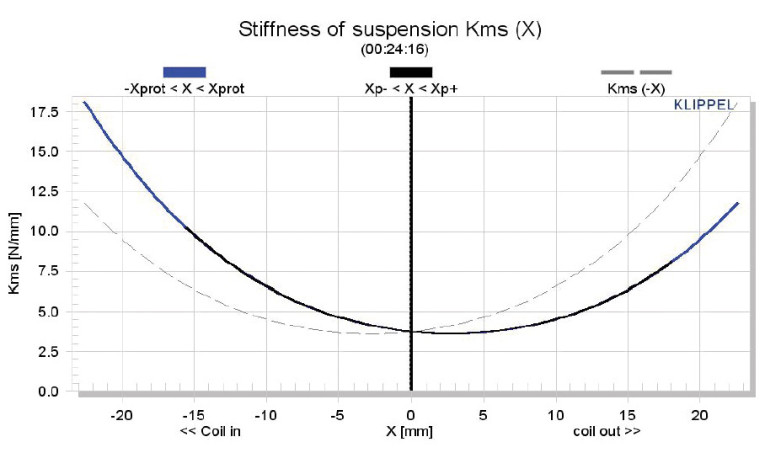

The Celestion CF18VJD’s Klippel analysis produced the Bl(X), KMS(X), and Bl and KMS symmetry range plots shown in Figures 5–8. Klippel provides our analyzer and Patrick Turnmire, Redrock Acoustics (SpeaD and RevSpeaD transducer software) performs the testing.
The CF18VJD’s Bl(X) curve shown in Figure 5 is nicely broad and symmetrical. Figure 6’s Bl symmetry plot shows a minor 0.81-mm coil-in offset at the rest position and remains nearly constant out to the driver’s physical XMAX, which is quite good. Figures 7 and 8 show the Celestion CF18VJD’s KMS(X) and KMS symmetry range curves. The KMS(X) curve is as also rather symmetrical but with some obvious forward coil-out offset. Looking at the KMS symmetry range curve, the forward offset is a fairly trivial 2.8 mm at rest and stays constant throughout the operating range, which suggests a small mechanical offset in the physical parts, but it is not hearable.
The CF18VJD’s displacement-limiting numbers (calculated by the Klippel analyzer) were XBl at 70% (with the Bl decreasing to 70% of its maximum value), which was greater than 9.9 mm. The crossover at 50% (compliance decreasing to 50% of its maximum value) was 6.2 mm (just beyond the physical XMAX), which means for this Celestion CF18VJD, the compliance is the most limiting factor for the prescribed 20% distortion level. Figure 9 shows the CF18VJD’s inductance curve L(X).
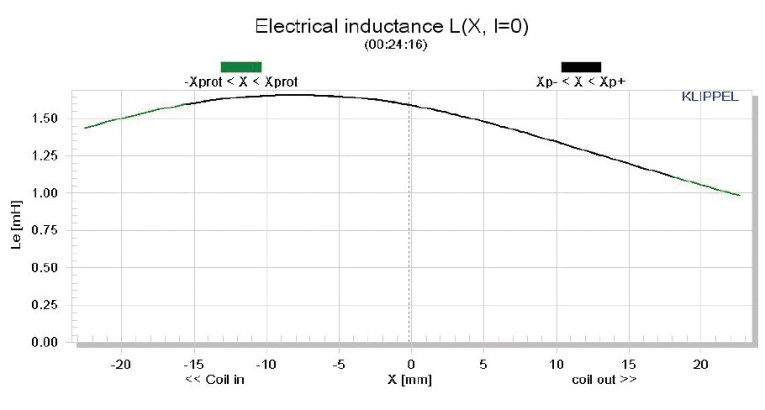
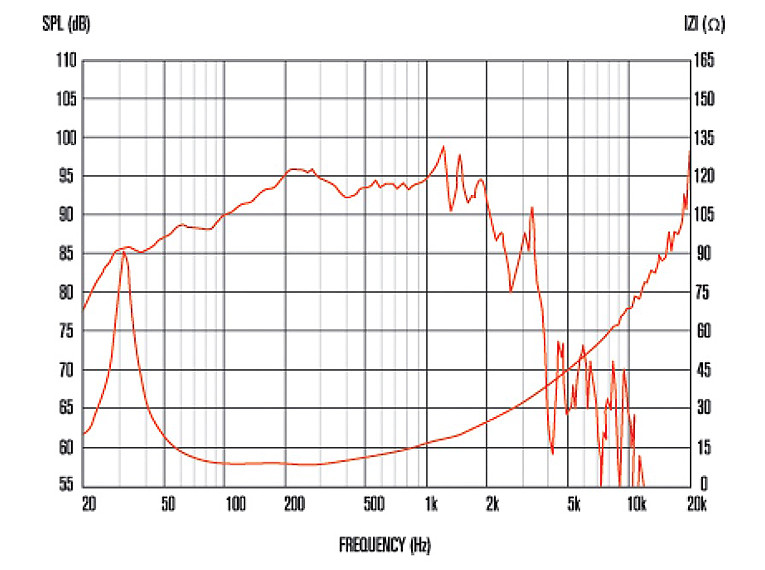
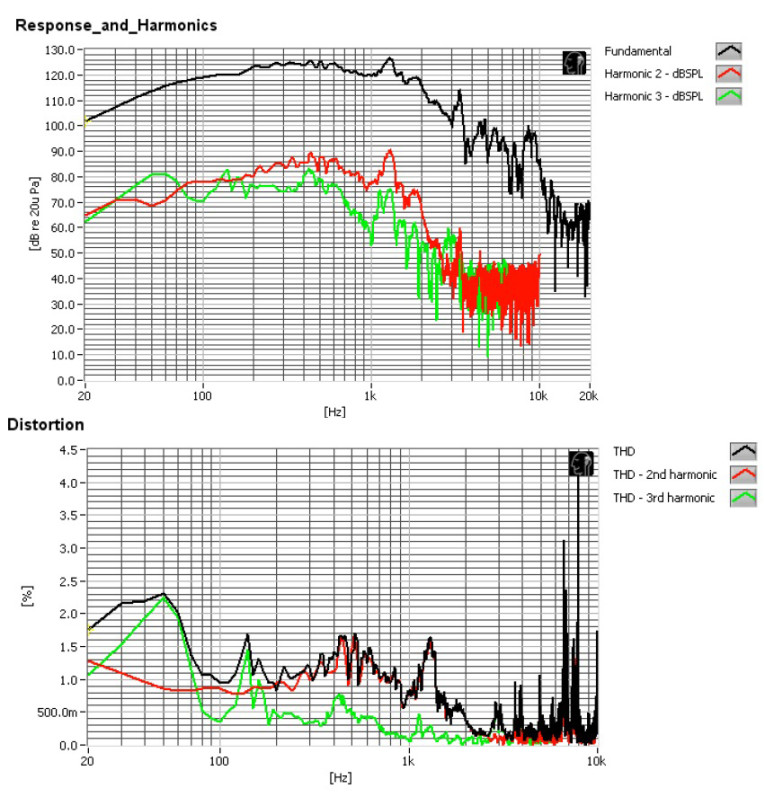
Inductance will typically increase in the rear direction from the zero rest position as the voice coil covers more pole area unless the driver incorporates a shorting ring. The CF18VJD has a dual shorting ring configuration, which in this case doesn’t do much for the inductance values, but does minimize the L(I) inductive current, which is good.
I dispensed with the SPL measurements for the CF18VJD, mostly because I don’t keep 18” or 21” size cabinets in my inventory of test fixtures. However, Figure 10 provides the factory SPL curve. Since I did not perform SPL measurements, I moved on to the last group of tests. I used the Listen SoundCheck AmpConnect analyzer, SC-1 microphone and SoundConnect power supply (courtesy of Listen) to measure distortion. Because I did not have an available enclosure, I did not use Listen’s SoundMap software for time-frequency presentations.
To set up for the distortion measurement, I mounted the woofer rigidly in free-air and used a noise stimulus (SoundCheck has a software generator and SPL meter as two of its utilities) to set the SPL to 104 dB at 1 m. Then, I measured the distortion with the Listen microphone placed 10 cm from the dust cap. Figure 11 shows the CF18VJS’s distortion curves.
Celestion has delivered a well-designed and extremely robust 18” for pro-sound woofer for public address (PA) applications. The CF18VJD also has a number of fairly unique proprietary features. For more information on this and other pro sound products from Celestion, visit www.celestion.com
This article was originally published in Voice Coil, November 2013.






